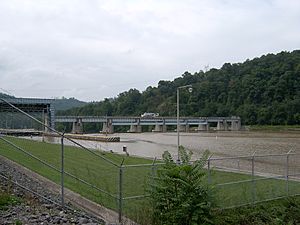Hildebrand Lock and Dam facts for kids
Quick facts for kids Hildebrand Lock and Dam |
|
|---|---|
 |
|
| Location | Monongalia County, West Virginia, USA |
| Coordinates | 39°34′58″N 80°00′40″W / 39.58278°N 80.01111°W |
| Construction began | 1950 |
| Opening date | 1960 |
| Operator(s) | U.S. Army Corps of Engineers, Pittsburgh District |
| Dam and spillways | |
| Impounds | Monongahela River |
The Hildebrand Lock and Dam is a very important structure on the Monongahela River in West Virginia. It helps boats travel safely along the river. It's made up of two main parts: a lock and a dam.
A lock is like a water elevator for boats. It helps them move between different water levels. A dam is a strong wall that holds back water. It helps control the river's depth. This makes sure the river is deep enough for boats to pass through. The Hildebrand Lock and Dam is maintained by the U.S. Army Corps of Engineers, Pittsburgh District.
What Does the Hildebrand Lock and Dam Do?
The Hildebrand Lock and Dam is part of a system of dams along the Monongahela River. This system helps keep the river at least 9 feet deep. This depth is needed for boats to travel all the way from Fairmont, West Virginia, to Pittsburgh, Pennsylvania.
The Hildebrand Lock has one special room called a lock chamber. This chamber is on the left side of the river as you look downstream. The water above the dam stretches about 7.4 miles upstream. It connects to the Opekiska Lock and Dam. The water below the dam goes for about 6.0 miles. This lower section is formed by the Morgantown Lock and Dam.
History of the Hildebrand Lock and Dam
Building the Hildebrand Lock and Dam started in 1950. It took ten years to complete, finally opening in 1960. This new structure replaced older ones called Locks 12 and 13. Those old locks were made of timber (wood) and were built way back in 1903. The new dam and lock were much stronger and more modern.

